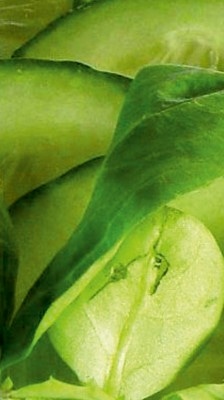Cucumber/Pickling Cucumber Disease Management
Downey Mildew
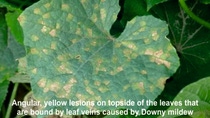
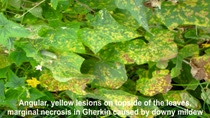
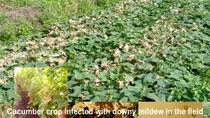
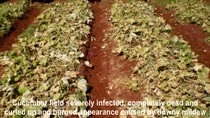
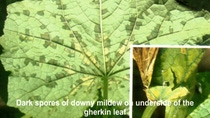
Causal Agent: Pseudoperonospora cubensis .
Distribution: Worldwide
Pseudoperonospora cubensis is a fungal-like organism that belongs to the Kingdom Straminipila and phylum Oomycota. P. cubensis, is a biotroph or obligate parasite, meaning that the organism requires living host tissue to grow and reproduce. The organism cannot be propagated on artificial media. P. cubensis overwinters on infected cucurbits.
Identification:
Downy mildew affects plants of all ages. Although the disease only infects foliage, a reduction in photosynthetic activity early in plant development results in stunted plants and yield reduction, especially in cucumber. Premature defoliation may also result in fruit sunscald due to overexposure to direct sunlight. symptoms on cucumber are angular lesions that are limited by the leaf veins. During periods of leaf wetness from dew, irrigation or rainfall, initial lesions can become conspicuously water soaked. Early lesions are light green in appearance and become chlorotic and finally necrotic as host plant cells die. Severe infection results in leaves that are completely dead and curled up. This symptom has been described as “wildfire” as the leaves appear to be burned.
Life Cycle/ Favourable Environmental conditions for the disease:
Pseudoperonospora cubensis causes a polycyclic disease. Sporangia are the source of primary inoculum. Sporangia are transported from infected plants via wind currents and travel to local or distant places. Optimal temperature for sporulation is 15˚C with 6 to 12 hours of available moisture. Symptomatic plants with yellow lesions have the greatest sporulating capacity. Sporangia and sporangiophores are greatly affected by changes in temperature and humidity. symptoms appear 3-12 days after infection, depending on temperature, presence of free moisture and inoculum dose. High temperatures (>35ºC) are not favorable for disease development. However, if cooler nighttime temperatures occur, disease development may progress.
Control:
1. Plant early in the season to escape high disease pressure
2. Do not allow water to remain on leaves for long periods of time
3. Downy mildew severity can be decreased by taking actions that encourage airflow and reduce leaf wetness.
4. Scout plants often and remove the infected plants.
5. Field sanitation by burning crop debris to reduce the inoculums.
6. Decrease moisture in the plant canopy.
7. Plant tolerant varieties, if available
8. Protect the crop with fungicides.
Gummy Stem Blight
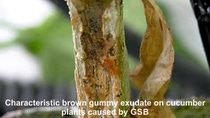
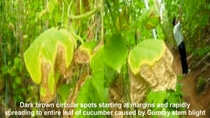
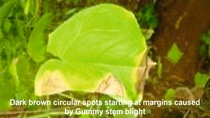
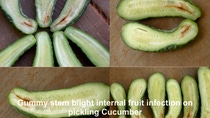
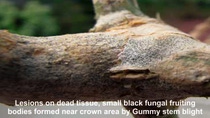
Causal Agent: Stagonosporopsis cucurbitacearum; (previously, Didymella bryoniae)
Distribution: Worldwide
Identification:
Gummy stem blight causes ovate stem and vine cankers, usually starting near the nodes, with a characteristic brown gummy exudate. Within advanced lesions on dead tissue, small black fungal fruiting bodies, known as pycnidia. Pycnidia contains pathogen conidia. Leaves can exhibit dark brown circular spots starting at margins and rapidly spreading to entire leaf. These foliar lesions can vary in color from light brown to nearly black. Black rot infected fruits show small water-soaked spots that advance into large brown spots, sometimes also exhibiting the brown gummy secretion as found in stems.
Life Cycle/ Favourable Environmental conditions for the disease:
Gummy Stem Blight occurs throughout India. Temperature and moisture are the most important factors in the spread of Gummy Stem Blight. For cucumber, the best temperature for infection is around 25 °C. Continuous leaf wetness from 2-10 hours is necessary for germination, sporulation, and colonization of conidia. After infection occurs, large brown lesions will retain moisture for long periods of time. Even though it takes constant moisture to facilitate the pathogen, it is highly resistant to dry conditions and can survive as chlamydospores for over a year in dry organic debris.
Disease transmission:
The pathogen survives on surrounding weeds, or organic debris from previously infected cucurbits. Without a host, the pathogen is able to overwinter and survive for over a year as chlamydospores, hardened masses of hyphae that act as survival structures during dry or adverse conditions. The pathogen is transferred from infected hosts to healthy plants via ascospores carried in the wind and by conidia that are released from pycnidia by water splash and in gummy exude. They can survive for up to 2 years. Spread is by splashing water, wind-driven rain, and on fingers, knives and clothing during cultural operations. Development of the disease depends on how long the leaves, stems and fruits stay wet so that spores can germinate, infect, and for the fungus to continue to grow.
Control:
1. After planting, check the seedling at least twice a week. If spots are seen on the leaves, remove them to delay the spread of the disease.
2. Avoid overhead irrigation as water splash spreads this fungus, or if overhead irrigation is used, apply early in the day so that the plants dry quickly.
3. Harvest carefully, cutting the fruit from the vine; do not pull them off. Sterilize the knife frequently by wiping it in 1% bleach.
4. Remove wilted or dead leaves frequently as they may contain spores of the fungus.
5. Remove weeds, so air can circulate around the plants to helping for the drying of wet leaves.
6. Collect and burn, bury, or compost the debris as soon as the harvesting is completed. The fungus can remain alive in stems, in the soil surface for several months and release spores at favorable condition.
7. Do not plant cucumbers, where cucurbits were grown previously. Leave a break of three years. The fungus can survive in the soil and plants remains.
8. Rotate the crop with non-cucurbits crops.
9. Avoid injuries during fruit harvesting, packing and storage.
Foliar Necrosis
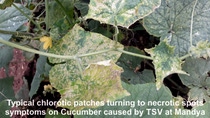
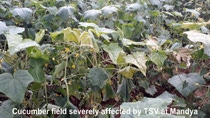
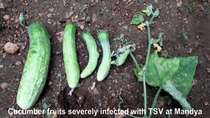
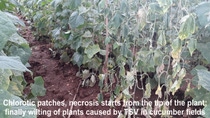
Pathogen: Tobacco streak virus (TSV)
Vector: spread is assisted by thrips sps.
Taxonomy position: Genus: Ilarvirus, family: Bromoviridae
The Tobacco streak virus (TSV) had caused severe epidemics in India on several important crops such as groundnut, sunflower, okra, cotton, cucurbits, and gherkins. However, in recent years, vegetable crop cultivation (okra, gherkin, cucumber, pumpkin) has been seriously hampered due to TSV infection.
Identification:
Symptoms were tip necrosis characterized by necrotic lesions on leaves, and a general leaf and stem necrosis extending to mid veins, petioles, flower buds and tip, eventually resulting in dieback of vines. Chlorotic patches later turning necrotic on leaves; yellowing of leaves; necrosis starts from the tip of the plant; finally wilting of plants. TSV infection at seedling stage results in premature death of the plant, Infection during mid-stage of the plant growth may result in necrosis of the leaves and severe reduction in yield.
Life Cycle/ Favourable Environmental conditions for the disease:
One or more modes of transmission have been demonstrated for each member of the genus Ilarvirus. All ilarviruses can be transmitted by mechanical inoculation to experimental hosts, although some with difficulty. The Ilarviruses tend to have a wide experimental host range. The TSV is transmitted to natural hosts in a process known to be facilitated by Thrips. There are many species of thrips know to transmit, but in India, the TSV transmission may be is supported by Thrips tabaci.
Control:
1. Growing of border crop of two rows of Maize/jowar
2. Mulching with silver or white polythene agro mulch sheet
3. Use of yellow and blue colour sticky traps 30 to 50 per acre
4. Spraying systemic insecticides combined with neem-based pesticides, don’t use the same chemicals, always use the alternative chemicals on every spray schedule.
5. Growing of virus tolerant verities.
Cucumber Mosaic (CMV)
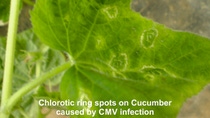
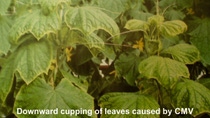
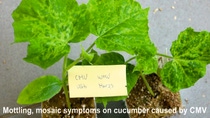
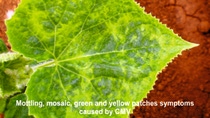
Pathogen: Cucumber Mosaic Virus (CMV)
Vector: Many aphids species
Taxonomy position: Genus: Cucumovirus, family: Bromoviridae
Identification
Symptoms of cucumber mosaic can vary greatly depending on the crop infected and the age of the plant when infection occurs. The most common symptoms include severe mosaic, mottling, chlorosis, necrosis, and distortion in leaves, severely stunting of growing tips. Almost all cucurbits are susceptible to CMV, with symptoms varying in severity. Severe epinasty, downward bending of the petiole and leaf surface along with leaf reduction, are common in early infection of cucumbers.
Life Cycle/ Favourable Environmental conditions for the disease:
Generally, aphids appear in November and remain active till April. Cloudy and moist weather favors rapid multiplication of the pest. This virus has a wide host range. CMV can overwinter in perennial plants and weeds. Cucumber mosaic virus occurs worldwide and is considered as very important disease in temperate, tropic and subtropic regions of the world. Crop losses vary from year to year since the amount of disease occurrence depends upon the number of aphids available for virus transmission in the spring or fall when the crops are established as determined by geographical location. If the spring or fall is cool and wet, aphid numbers are decreased and virus spread is sporadic, with infected plants primarily located in rows bordering the edges of the field. However, if the spring or fall is warmer with less frequent rains, aphid populations increase rapidly on perennial crops that harbor CMV,
Disease Transmission:
This virus is transmitted by Aphids in a non-persistent manner (Stylet borne) and more than 80 aphids species associated with CMV transmission. Acquisition and transmission occur in very short time. The aphids cannot retain the virus for long time and have to acquire the virus repeatedly for the transmission to new plants. This virus is also mechanically transmitted. The Virus host plants can be a seasonal and perennial also. some may show clear symptoms while others are symptomless carriers.
Control:
1. Growing of border crop of two rows of Maize/jowar
2. Mulching with silver or white polythene agro mulch sheet
3. Use of yellow and blue colour sticky traps 30 to 50 per acre
4. Spraying systemic insecticides combined with neem-based pesticides, don’t use the same chemicals, always use the alternative chemicals on every spray schedule.
5. Growing of virus tolerant varities.
Cucumber Mosaic (ZYMV)
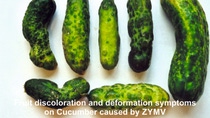
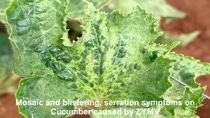
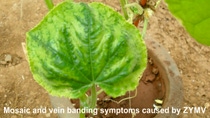
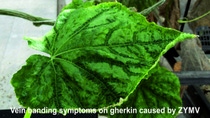
Pathogen: Zucchini Yellow Mosaic Virus (ZYMV)
Vector: Many aphids species
Taxonomy position: Genus: Potyvirus, family: Potyviridae
Identification:
The leaf symptoms of ZYMV infection are severe mosaic, deformation, blistering and reduced size. Infected plants are stunted. Fruit symptoms on cucumber include mottled skin, uneven colouring and knobby areas that cause prominent deformations. Infected cucumber fruits often have poorly formed surface ‘netting'. Infected fruit has reduced shelf life. Symptoms are similar to those caused by infection with papaya ringspot virus and watermelon mosaic virus.
Life Cycle/ Favourable Environmental conditions for the disease:
The virus needs living plants to survive and cannot live in soil or dead plant material. ZYMV infection is usually confined to plants in the cucurbit family. The main sources of ZYMV are old diseased cucurbit crops, volunteer or self-sown cucurbits and cucurbit weed species. The infected old crop plants, weeds and native cucurbit species allow the virus to survive between growing seasons. ZYMV is spread from these infected plants to young crops by aphids.
Disease Transmission:
ZYMV is transmitted non-persistently. This means an aphid picks up the virus within 1-2 seconds while probing an infected plant and then transmits the virus within 1-2 seconds to healthy plants. After the aphid has probed one or two healthy plants the virus is lost to the aphid until it probes another infected plant.
Control:
1. Remove and destroy old cucurbit crops immediately after the final harvest – to minimize the virus spread to new crops.
2. Destroy any wild or self-sown cucurbit plants and weeds before planting – to reduce any potential virus and aphid sources for new crops.
3. Remove any cucurbit plants showing virus symptoms, particularly before fruit set – removing virus sources within the crop may help to slow down the spread of the virus to nearby plants.
4. Monitor surrounding weeds and crops for aphid populations.
5. Plant a tall non-host border crop around the cucurbit crop about two weeks before planting, a non-host border acts as a cleansing barrier for aphids. Infective aphids that feed on it will lose the virus and will no longer be infective when they land on the cucurbit crop.
6. Use good hygiene practices - Use 1:4 dilution of household bleach or one per cent Virkon for foot baths and to wash equipment and machinery.
7. Avoid moving machinery, equipment, and workers from old crops to new ones – to minimize spread from older to young crops.
8. Use virus tolerant cucurbit varieties, if available
Powdery Mildew
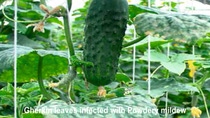
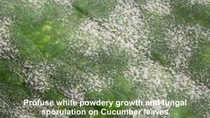
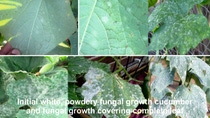
Causal Agent: Podosphaera xanthii.
Distribution: Worldwide
Identification
Cucumber powdery mildew causes white, powdery fungal growth on leaves, stems, and petioles. Symptoms usually develop on the bottom surface of older leaves first, but all leaves become diseased as plants age. Infected leaves wither and die, leading to premature defoliation. Powdery mildew can reduce fruit yield and size.
Life Cycle/ Favourable Environmental conditions for the disease:
The disease prefers moderate temperatures of 20-26°C, medium to high humidity (50-90%), dense foliage, and low light. Infections can occur under dry conditions of relative humidity as low as 50%. disease development is favored by vigorous plant growth and moderate temperatures.
Disease transmission
The pathogens generally overwinter on weeds and their spores can be carried to long distances by air currents. The pathogen survives via conidia carried by wind over long distances.
Control:
1. Use of resistant cultivars, if available.
2. Give sufficient /adequate plant spacing for good air movement.
3. Remove debris, weeds, and volunteers that may harbor the pathogen
4. Application of fungicides to protect the crop
Tomato Leaf Curl Virus
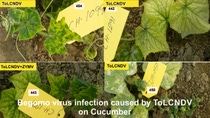
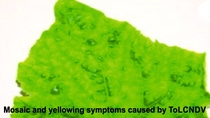
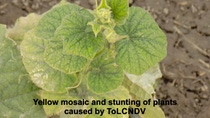
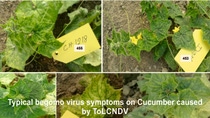
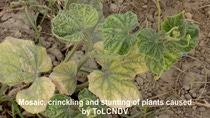
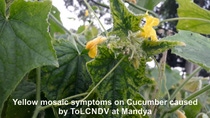
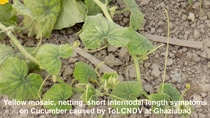
Vector: Whitefly (Bemisia tabaci).
Taxonomy: Genus Begomovirus and the family Geminiviridae
Distribution: Many countries including India
Identification:
The ToLCNDV infected plants, leaves in upper part of plant showing yellowing mosaic, puckering, and stunting of the plants. The other symptoms include curling and severe mosaic of the young leaves, very short internodes, fruit skin roughness and longitudinal cracking of the fruits, leading to terrible losses.
Life Cycle/ Favourable Environmental conditions for the disease:
Symptoms are caused by begomovirus, which is primarily transmitted through the whiteflies in a persistent-circulative non-propagative manner. They are characterized as 1.5mm long, waxy white wings with a pale-yellow body and are frequently found on the lower sides of leaves. The spread of the disease depends on the wind condition, which will indicate how far the whiteflies can travel. Whiteflies are most problematic in throughout the year and seasons. Since the virus is not seed borne, the virus persists in alternate host and weeds. ToLCNDV is efficiently spread by whitefly (Bemisia tabaci) which is abundant year-round in tropical and subtropical climates where wide variety of hosts serves as reservoirs. Environmental factor particularly temperature plays important role in transmission and vector movements, Virus transmission, latent period, infectious period, replication, titer, movements, and symptoms expression etc. are directly linked to temperature.
Disease Transmission:
ToLCNDV is transmitted by an insect vector Bemisia tabaci in a persistent-circulative non-propagative manner. Transmission of the monopartite genome alone can lead to infection, but the presence of DNA A or DNA B helper viruses plays a large role in symptom development.
Control:
1. Use of available resistant varieties like Belle.
2. Raise at least two rows of a barrier crop such as maize, sorghum, or pearl millet around your fields.
3. Control whitefly population and protect particularly from them by establishing nylon nets (60 mesh size) over the nursery.
4. Monitor regularly to detect early infections by looking for symptoms of curled leaves and stunted growth.
5. Install several sticky yellow traps or sheet in your fields that attract whiteflies
6. Control the vector by growing seedlings under the net, which can also prevent whiteflies attack the seedlings.
7. Ensure a weed free field and surroundings.
8. Collect and destroy early infected plants by burning them.
9. Plough deep or burn all the plant debris after harvest.
10. Amblyseius swirskii is a commercially available predatory mite that is capable of significantly controlling a whitefly population.
